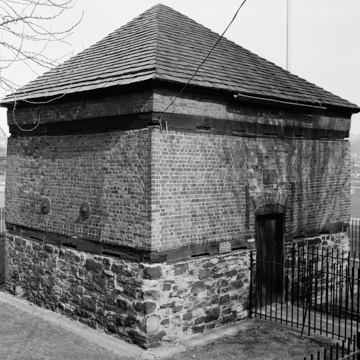These remnants are the physical core of Pittsburgh and the metaphorical core of western Pennsylvania. In 1753, a twenty-one-year-old George Washington urged Virginia's Governor Robert Dinwiddie to erect a fort at the Forks of the Ohio. The next year, Virginia constructed Fort Prince George at the Point, but it was replaced almost immediately by the French Fort Duquesne, a four-bastioned fort of which nothing remains today but a few artifacts and a modern stone outline showing the location. When the British dislodged the French in 1758, they put up a hasty replacement, but also began construction of an elaborate five-bastioned pentagonal fortress with earthen breastworks, thirteen-foot-high brick revetment walls, and stone quoins. The total perimeter of the fort and its escarpments was about half a mile; it was protected on the landward side by extra earthworks and a moat.
The fort barely withstood a siege during Pontiac's Rebellion of 1763, spurring Colonel Henry Bouquet to add two redoubts for sharpshooters; one survives as the pentagonal Blockhouse. While the Blockhouse—probably the oldest building in western Pennsylvania—survives, though almost totally rebuilt, the Fort itself was demolished in 1797, and its million bricks went into the town's new homes and warehouses. The fort site was overrun in 1852 by the tracks of the Pennsylvania Railroad, which, for a century, used the Point as a freight depot. When archeologists from the Carnegie Museum of Natural History ascertained in 1941 that the fort's foundations were still intact about ten feet below the industrial detritus, Charles Stotz undertook a meticulous, though partial, reconstruction of its primary walls and two bastions.
Access to Point State Park from Gateway Center is cut off by eight lanes of highway traffic. The park's main entrance has such a low clearance that architect Gordon Bunshaft of Skidmore, Owings and Merrill suggested a flattened arch portal to Charles Morse Stotz (1898–1985), who used post-tensioned concrete for its three ribbed arches. The inventor of that concrete technique, eminent French engineer Eugène Freyssinet came to Pittsburgh to personally supervise its construction. A wide pedestrian bridge at its center funnels visitors away from the low edges and carries them over a cobblestoned reflecting pool into the park.


